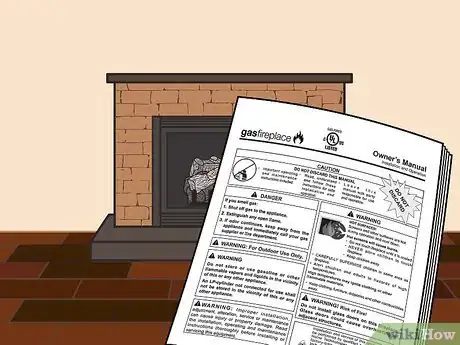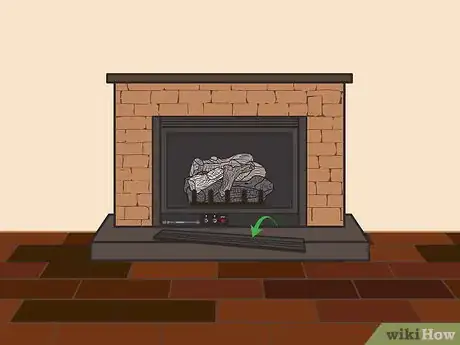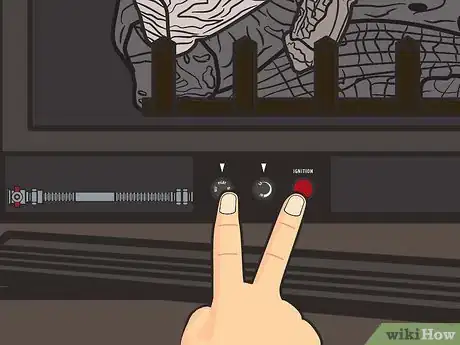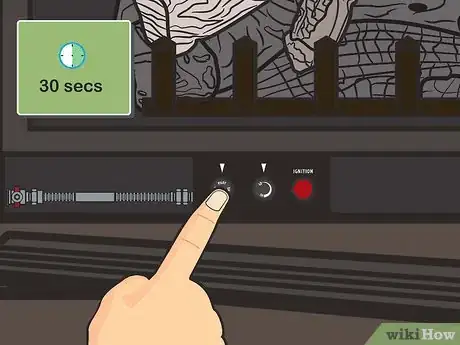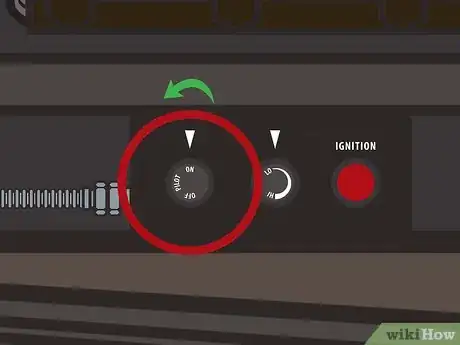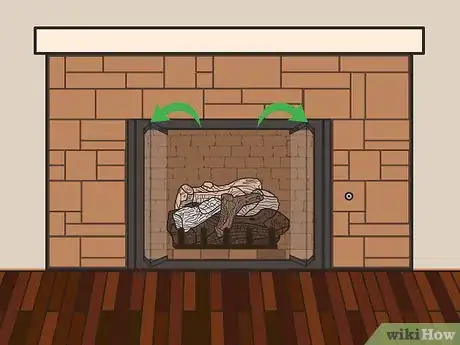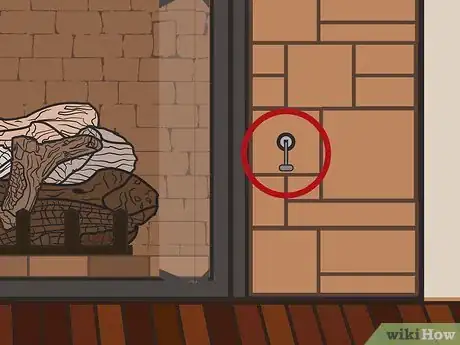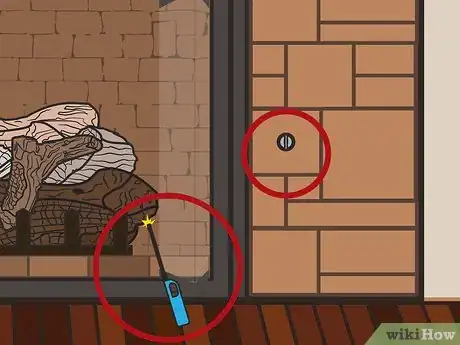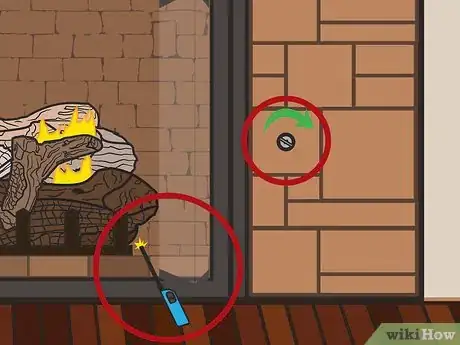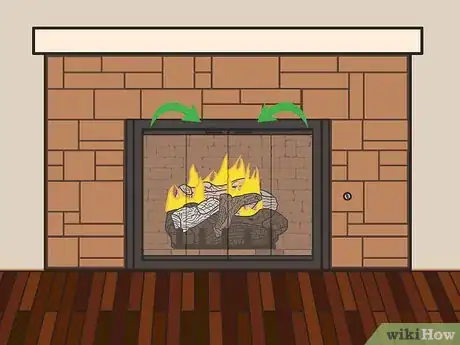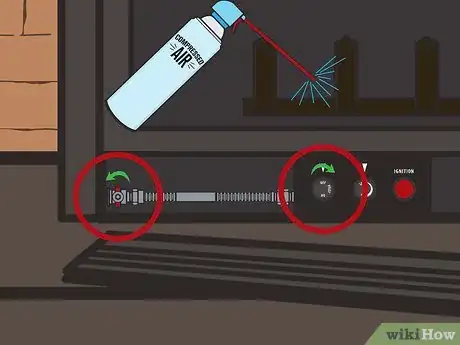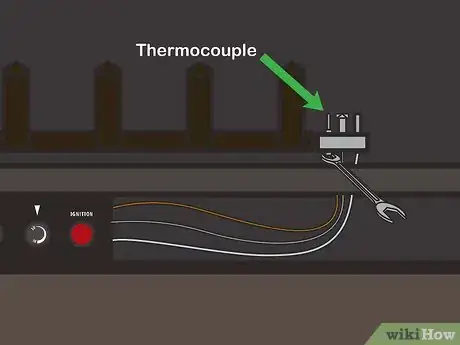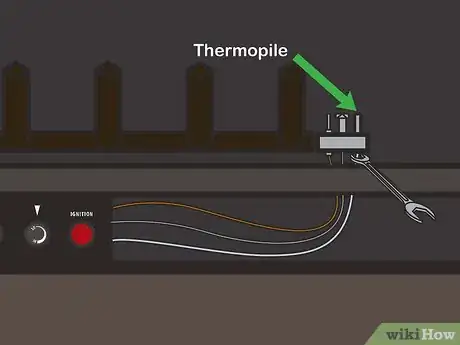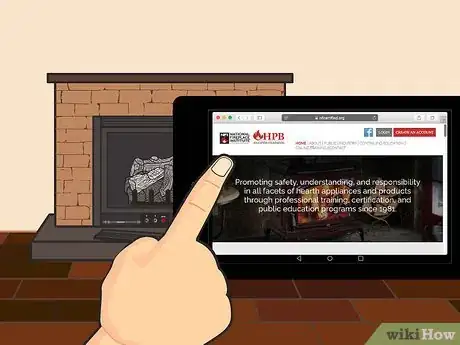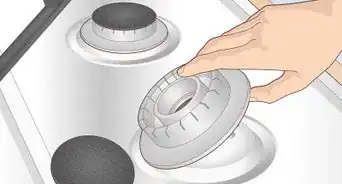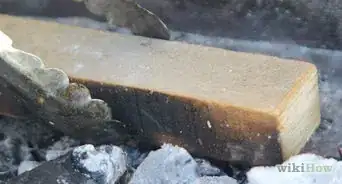This article was co-authored by wikiHow Staff. Our trained team of editors and researchers validate articles for accuracy and comprehensiveness. wikiHow's Content Management Team carefully monitors the work from our editorial staff to ensure that each article is backed by trusted research and meets our high quality standards.
There are 9 references cited in this article, which can be found at the bottom of the page.
This article has been viewed 601,348 times.
Learn more...
Gas fireplaces provide all the warmth and atmosphere of a traditional fire without the ashy cleanup. Powered by a natural gas line or propane gas tank, these household fixtures are simple to use and take only a few minutes to get up and running.
Steps
Lighting with a Control Panel
-
1Read your fireplace’s user manual thoroughly. Before lighting or adjusting your fireplace, read the included user manual thoroughly. Though most fireplaces use similar ignition methods, yours may have a specific element or feature that, when handled improperly, could be dangerous.[1]
- If you do not have a user manual, check online or contact the fireplace’s manufacturer to get a copy.
-
2Locate and open your fireplace’s control panel. Most modern gas fireplaces come with a specialized control panel that manages the fixture’s pilot light. For aesthetic purposes, you’ll typically find this panel hidden behind the fireplace’s front screen, which you can open or remove to gain access.[2]
- On most gas fireplace models, you can remove the screen by simply tugging it off the device.
Advertisement -
3Turn the control knob to the off position for at least 5 minutes. Look for a knob on your control panel with the words On, Off, and Pilot on it. If the knob is not in the off position, turn it so that it is. Then, let your fireplace sit for at least 5 minutes, allowing any excess or lingering gas to clear out.
- If you smell a faint amount of gas, open your windows and doors to ventilate the area.
- If you smell a large amount of gas, leave the house immediately and call your natural gas provider or propane dealer. If you can’t get a hold of either, call your local fire department.
-
4Twist the shutoff valve until it is parallel with the gas line if necessary. Most fireplace manufactures attach a shutoff valve to the device’s gas line, giving you greater control over your natural gas or propane output. If your fixture comes with 1 of these valves, make sure to move it until the handle sits parallel to the gas line, allowing fuel to enter the fireplace.[3]
-
5Move the control knob to the pilot position. This will give you access to the device’s pilot light, or the small flame that helps the fireplace burn. To avoid any hazardous mistakes, do not twist the knob until you are ready to ignite the pilot light.[4]
-
6Press the control knob down and hit the ignition switch. To ignite the pilot light, press your finger into the center of the control knob and hold it in place. Then, hit the fireplace’s ignition switch, which is typically a red button located near the control knob. Tap the switch until the pilot light ignites.[5]
- If the pilot light fails to ignite after multiple attempts, restart the entire process and try again. If it continues to fail, check for any common ignition problems or call a professional for help.
-
7Hold the control knob down for at least 30 seconds. To keep the flame alive, you’ll need to hold the control knob down for a minimum of 30 seconds, possibly even longer. This will give the thermocouple, a safety device that stops the gas flow if the pilot light shuts off, a chance to heat up and register that the pilot is back on.[6]
-
8Move the control knob to the “on” position. With the pilot light ignited, turn your fireplace’s control knob from the pilot position to the on position. This will make sure the pilot light stays on indefinitely, allowing you to activate the fireplace whenever you wish using the device’s wall switch or remote control. When you’re finished, remember to replace the fireplace’s front screen if you had to remove it.[7]
- Be aware that, while a power outage should not affect your fireplace’s pilot light, it may deactivate any switches regulating the gas output.
Igniting with a Fireplace Key
-
1Look over the user manual included with your fireplace. Every fireplace is different, so check your model’s user manual before lighting or adjusting it. While the ignition method will most likely be similar, knowing the ins and outs of your specific fireplace will help you avoid any dangerous, and possibly even lethal, accidents.[8]
- Contact the fireplace’s manufacturer if you do not have a copy of the user manual.
-
2Remove your fireplace’s outer cover. For both safety and aesthetic reasons, gas fireplaces come with a front cover separating the fire chamber from the rest of the room. To ignite the pilot light, you’ll need to open or completely remove this cover. These panels are typically made of glass, so lay yours in a safe area to prevent unnecessary damage.[9]
- In most cases, you can remove a gas fireplace cover by simply pulling it off the device.
-
3Put a fireplace key into the device’s gas valve knob. To ignite your device’s pilot light, you’ll need to insert a fireplace key into the gas valve knob located to the left or right of the fireplace. Once you insert the key, do not turn it until after preparing your lighter, otherwise you may release a dangerous amount of gas into the room.[10]
- Some fireplaces may have this key permanently installed in the wall.
- If you do not have a key, you can purchase a replacement at most home improvement stores. Make sure to check your user manual to see what kind of key the fireplace takes.
-
4Hold a long lighter up to the burner and ignite it. Before turning the gas valve knob, grab a lighter with a long enough head that you can insert it into the fireplace while keeping your hands away from the fire pit completely. Then, place the head of the lighter next to the device’s burner and pull the lighter’s fuel trigger. Be prepared to move your hands back quickly if the pilot light ignites unexpectedly.[11]
- For safety, put on heat resistant gloves before operating the lighter.
- If you do not have a long enough lighter to safely ignite the fireplace, insert a lit match next to the burner instead.
- Depending on how far away the gas valve knob is, you may need to have a friend hold the lighter or operate the key.
-
5Turn the gas key. With the lighter activated, move the gas valve knob about half a turn counter-clockwise. This will release gas into the fireplace, causing the pilot light to ignite. Be prepared to move back quickly in case the fire ignites stray gas particles and flares out into the immediate surrounding area.[12]
- If you smell a small amount of gas, remove the lighter and open your windows and doors to air the room out.
- If you smell a lot of gas, remove the lighter and exit the house immediately. Then, contact your propane dealer or natural gas provider. If neither are available, contact your local fire department.
-
6Replace the fireplace’s outer cover immediately. To keep any excess gas from escaping into the room, cover your fireplace with the front panel you removed earlier. Once the cover is secure, you can safely control the fireplace using the gas valve key, turning it counter-clockwise to increase the flames and clockwise to decrease them.[13]
Fixing Common Ignition Problems
-
1Clean your burner plate to remove carbon residue. Over time, the holes inside your burner plate can get clogged up with carbon residue, preventing gas from reaching the pilot light. To fix this, shut off the pilot light and close the gas valve. Then, blow the holes clean using a can of compressed air.
-
2Replace your thermocouple if the pilot light won’t stay lit. If your pilot light ignites when you activate it but goes out soon after, you may have a defunct thermocouple that needs to be changed out. To do so, disconnect the thermocouple from the burner and remove it with a wrench. Find a matching device at a hardware store, then attach it to your fireplace by following the included instructions.[14]
- To find your thermocouple, look for a small rod located next to the pilot light burner.
-
3Change out the thermopile if the fireplace won’t ignite. Thermopiles are small, round metal probes that, when activated, create electricity and open your fireplace’s gas chamber. If your pilot light stays on but your fireplace will not work, you may need to replace the thermopile. To do so, disconnect the probe from your burner and remove it with a wrench. Then, replace it with a matching thermopile by following the instructions included with the new device.[15]
- Look for replacement thermopiles at hardware and home improvement stores.
-
4Hire a professional if you can’t get your fireplace to work. If you can’t figure out what’s wrong with your fireplace, search online for a gas specialist certified by the National Fireplace Institute. These professionals know all the ins and outs of gas fireplaces and can both figure out the problem and give you an estimate for how much it will cost to fix.[16]
Community Q&A
-
QuestionMy gas fireplace pilot light is on, but I cannot get the fire to light. What could be the problem?
 Community AnswerIs it controlled with a wall switch? The thermopile may not be conducting enough voltage to activate the switch. Try cleaning off the thermopile with some fine steel wool or sand paper.
Community AnswerIs it controlled with a wall switch? The thermopile may not be conducting enough voltage to activate the switch. Try cleaning off the thermopile with some fine steel wool or sand paper. -
QuestionHow do I turn on the log set if the pilot light is already on?
 Community AnswerJust turn the dial to "on" instead of "pilot" and then flip the switch on the side of your fireplace.
Community AnswerJust turn the dial to "on" instead of "pilot" and then flip the switch on the side of your fireplace. -
QuestionShould the chimney vent be open when the logs are turned on?
 Community AnswerYes. Burning logs produces carbon dioxide as well as carbon monoxide, so the open vent is needed to get these harmful gases out of the house.
Community AnswerYes. Burning logs produces carbon dioxide as well as carbon monoxide, so the open vent is needed to get these harmful gases out of the house.
Warnings
- Lighting a gas fireplace involves combining a hot, dangerous material with a highly flammable substance. To keep yourself from getting injured, stay vigilant at all times and adhere to any safety instructions mentioned in your fireplace’s user manual.⧼thumbs_response⧽
References
- ↑ https://www.youtube.com/watch?v=CvL_fAFRIW8&feature=youtu.be
- ↑ http://archive.knoxnews.com/news/steps-outlined-for-getting-gas-fireplace-pilot-light-going-ep-410557379-359651961.html/
- ↑ http://www.iwilltry.org/b/projects/turn-off-the-pilot-flame-of-your-gas-furnace/
- ↑ http://archive.knoxnews.com/news/steps-outlined-for-getting-gas-fireplace-pilot-light-going-ep-410557379-359651961.html/
- ↑ http://archive.knoxnews.com/news/steps-outlined-for-getting-gas-fireplace-pilot-light-going-ep-410557379-359651961.html/
- ↑ http://www.iwilltry.org/b/projects/turn-off-the-pilot-flame-of-your-gas-furnace/
- ↑ http://archive.knoxnews.com/news/steps-outlined-for-getting-gas-fireplace-pilot-light-going-ep-410557379-359651961.html/
- ↑ https://www.youtube.com/watch?v=CvL_fAFRIW8&feature=youtu.be
- ↑ https://www.thisoldhouse.com/ideas/all-about-gas-fireplaces
- ↑ https://www.youtube.com/watch?v=61DP2Spo4qk&feature=youtu.be&t=1m30s
- ↑ https://www.diypete.com/how-to-make-an-outdoor-gas-fireplace/
- ↑ https://www.diypete.com/how-to-make-an-outdoor-gas-fireplace/
- ↑ https://www.thisoldhouse.com/ideas/all-about-gas-fireplaces
- ↑ https://heightslibrary.org/materials/hrrc/29-Heating-Cooling/THERMOCOUPLE_REPLACEMENT.pdf
- ↑ https://vtechworks.lib.vt.edu/bitstream/handle/10919/37014/chap2.pdf?sequence=3
- ↑ https://www.bobvila.com/articles/2051-gas-fireplaces-101/#.Wl7f7jdMFhE
About This Article
To light your gas fireplace, first access its control panel and turn the shutoff valve so the handle is parallel to the gas line, which will allow gas to enter your fireplace. Then, move the control knob to the “pilot” position. Next, press and hold the center of the control knob and hit your fireplace’s ignition switch until the pilot light ignites. Hold the control knob down for at least 30 seconds before you move it from the “pilot” position to the “on” position, which will keep the pilot on and let you activate your fireplace with the switch or by remote whenever you want. To learn how to light your gas fireplace if it has a key, read on!
